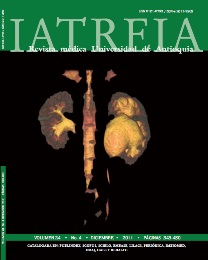Supracondylar fractures of the humerus in chil¬dren aged 2-14 years. Demographic profile and therapeutic approach at a third-level hospital in Medellín, Colombia
DOI:
https://doi.org/10.17533/udea.iatreia.10635Keywords:
Elbow, Epidemiology, Descriptive, Humeral FracturesAbstract
Introduction: Supracondylar fractures of the distal humerus are the most frequent injuries that require surgical treatment in the pediatric population. Reports on the demographic profile and the therapeutic approach of patients with these fractures in Medellín, Colombia, are limited. This study was carried out in order to know the local epidemiology of these lesions, and to detect during the follow-up the good therapeutic decisions and the mistakes, as a basis for more complex research.
Materials and methods: A comprehensive search was conducted of electronic medical records at a thirdlevel hospital; 205 cases of supracondylar fractures of the humerus were found in children aged 2-14 years, admitted to the emergency service (Hospital Pablo Tobón Uribe) between January 2005 and September 2009. Demographic and therapeutic aspects were analyzed.
Results: Average age was 6.6 years; 61.5% of the patients were males. In 62.4% fractures affected the left side. Classification (Gartland) was as follows: type I: 41.5%; type II: 12.2%; type III: 46.3%. Fractures were closed in 95.5% of the patients. Treatment was surgical in 103 patients (50.2%). Average time between admission and surgery was 6.7 hours. The most frequently used surgical technique was closed reduction with percutaneous fixation with crossed pins (45.6%). There were 31 cases of neurological injuries, 28 of which affected the ulnar nerve. Nine of the 31 were observed in the immediate postoperative evaluation and all of these occurred in patients treated with crossed pins. There were no vascular injuries or compartment syndromes.
Conclusion: This series presents the current demographic profile of patients with supracondylar fractures of the distal humerus in children, as well as the therapeutic approaches in a third-level hospital in Medellín, Colombia. These results may be the basis for future more complex studies.
Downloads
Downloads
Published
How to Cite
Issue
Section
License
Papers published in the journal are available for use under the Creative Commons license, specifically Attribution-NonCommercial-ShareAlike 4.0 International.
The papers must be unpublished and sent exclusively to the Journal Iatreia; the author uploading the contribution is required to submit two fully completed formats: article submission and authorship responsibility.














